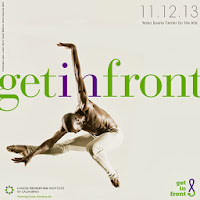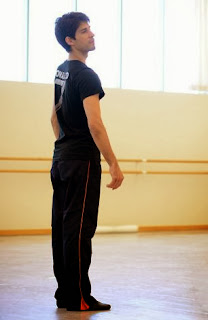It's a crazy thing, but just about every month of the year is
marked for awareness of some kind of cancer, from Melanoma Monday to Brain
Tumor Awareness Month to Thyroid Cancer Awareness Month. Sad to say, cancer is
on the minds of a huge cross-section of the human population, and with good
reason. According to the American Cancer Society, over a million people will be
diagnosed with cancer each year in the US alone. Odds are that one in two men
and one in three women will develop some type of cancer during their lives.
What you don't hear as much about is the research being done on
preventive measures, and that kind of work is what inspired the Get In Front gala, which raises money for the Cancer Prevention Institute of California.
The 2013 gala will take place at Yerba Buena's Lam ResearchTheater on November 12, and a constellation of stars from Bay Area dance
companies--including San Francisco Ballet, ODC, Ballet San Jose, AXIS DanceCompany, Smuin Ballet, Renegade Rockers, Zhukov Dance Theatre, Robert Moses'Kin Dance Company, LEVYdance, and Margaret Jenkins Dance Company--are on the
program.
Last year's Get in Front gala was an enormous success, selling
out the Herbst Theatre and raising nearly $150,000 for CPIC. This year the
logistics have been a challenge, with organizers James Sofranko, Garen Scribner
and Margaret Karl operating in two different companies, indeed, on two
different continents.
When they first conceived the gala, all three were dancing with
San Francisco Ballet, but since then Scribner has moved to Nederlands DansTheatre, based in The Hague.
 |
| James Sofranko and Garen Scribner |
I sat down to chat with Sofranko and Scribner at a cafe in San
Francisco when the former had returned from a New York tour and the latter
happened to be in the area for NDT's
shows at Cal Performances.
You're in two different cities, in two different companies, on
different continents--how you are both managing it this year?
JS: We have a good team of people! It's not just Garen and I, but
also our friend Margaret Karl, is also a producer of the show. She's handling
the after- and the pre- parties.
GS: there's the three of us and also a project manager that we
hired, as well as support from the CPIC staff, they take care of all the
administrative and back end details, which is great. Last year was our first
year doing the event so we had a huge learning curve. We really didn't know
what the project would end up looking like, and it ended up becoming a big deal,
completely sold out. As we went through that process though, we tracked what we did, how we did it, who took
care of it. So this year we were a little more specific about who would do
what. Jim has been in charge of communicating with the companies and dealing
with programming. Margaret is in charge of all of the events, contracts with
the theater, things like that. And I headed up the development portion, working
with sponsors and fundraising and community. And then creatively we handled the
details and big decisions as a group.
Who are some of the performers this year?
JS: Sarah Van Patten and Daniel Deveison are doing a pas de deux
from Yuri Possokhov's "Fusion." Michael McGraw will be playing live
for it.
GS: Also Isaac Hernandez's little brother Esteban, who just
joined San Francisco Ballet right out of the Royal Ballet School, will be doing
the Slave variation from Corsaire, and he is fabulous. Scott Marlowe
from LEVYdance is doing a solo, and ODC is bringing a work of Brenda Way's, Unintended
Consequences.
JS: And Ballet San Jose is sending a pas de deux with the Cuban
dancer Jorge Lopez Barani and Jumna Ige, they'll do Diana & Actaeon.
GS: Also there are two world premieres, one from Zhukov Dance Theater
and one from Axis Dance Company.
And are you guys choreographing this year?
JS: Not this year. Last
year I had a piece in it, but this year we had so many companies wanting to be
a part of it.
GS: Last year we didn't know what kind of participation we would
have, but so many people came forth and said yeah, we would love to be a part
of it. This year people sent us videos and so we were able to really look at
the program and figure out how to put it together with a greater variety.
JS: For galas you're bound to get a lot of pas de deux, so we
encouraged people to do group pieces this year, and that's been great. We have
larger works from Smuin Ballet, from Robert Moses' KIN, from Margaret Jenkins.
GS: Renegade Rockers, one of the oldest breaker crews in the
country will also be there, it's an amazing crew that has a group of kids that
they work with who are also unbelievable performers.
JS: We're going to have over 50 dancers total in the program.
And what is your fundraising goal this year?
GS: We would like to raise $250,000. It sounds like a lot, but a
goal is a goal for a reason, you shoot for it and if you hit it then great and
if not, you did your best and still got as close to it as possible. But we're
doing really well, and we've had some generous sponsorships from individuals
and organizations like The Fisher Family, Tim Dattels and Kristine Johnson, Reed
Krakoff, the Fullerton Family Foundation, Fremont Bank, Onyx Pharmaceuticals,
airBNB and Genentech, the support has been amazing.
JS: And the goal of course is to raise money, but it's also to
raise awareness about cancer prevention and the research CPIC does to prevent
cancer. Their research can inform all of us on a day-to-day basis on
practically every decision we make, from exercise to diet, to the air we
breathe --it all relates to cancer in our lives. Cancer is becoming more and
more prevalent and we need as much knowledge out there as possible.
Do you have a personal reason for wanting to support this
cause in particular?
JS: My grandmother had breast cancer, she survived, but still, it
was a scary experience for the family.
GS: And we recently lost a Ballet San Jose dancer to cancer.
JS: We lost two people in the ballet world actually. Tiffany
Glenn, from Ballet San Jose, and also one of our fly men at SFB, Kevin Rogers. he
was still with us last year and we dedicated
the show to him.
GS: What we've found is that getting exposure and raising
awareness for what CPIC does is difficult, because people don't want to talk
about cancer. It's something that they want to avert their eyes from, rather
than look at head on. What we really like about this organization and their
ethos is that it's about taking action now and thinking about what we can do
today to help us out in the future. I
like the organization for that reason. They're not so cure-oriented, they're not
looking for a fix. Trying to fix a problem when it's already there is so much
harder than stopping it before it starts. We thought that presenting world
class dance, with these incredible athletes and artists, in connection with
this cause was a perfect way to manifest that idea of prevention.
So how does it feel being on this side of a show, organizing
rather than performing? Do you like it?
JS: I do like it. It's a little more responsibility, but it
really gives you insight. I've all been on tour numerous times with San
Francisco Ballet, and as a dancer you don't really think about how all these
things are done. You go to your dressing room and there's a sign that tells you
where to go, the schedule is already made. Now I understand all the energy and
time that goes into making that happen.
Have you thought about
doing this kind of event in other places, or expanding this one?
JS: I think there is a lot of potential there, as we saw last
year doing this gala. There are artists who want to give back to the
community--musicians, visual artists, technical artists. There are so many way
that new ideas can come out of this. We want to look at how can we use
everyone's talents, pool them for the greater good of the community.
GS: I also think that there is a misconception out there that
high level, world class dance is out of reach for the general public, unless
you have experience, or you've danced yourself or you grew up watching it,
that it would be hard to appreciate it. I
think dancers internalize that attitude but that a performance like this, in a
way, gives them an opportunity to ground their work and put it in the context
of the broader scope of things. Being
able to give back this way makes dancers feel that what they do really means
something to the people around them--not just the donors and balletomanes, but
to everybody in the community.


























